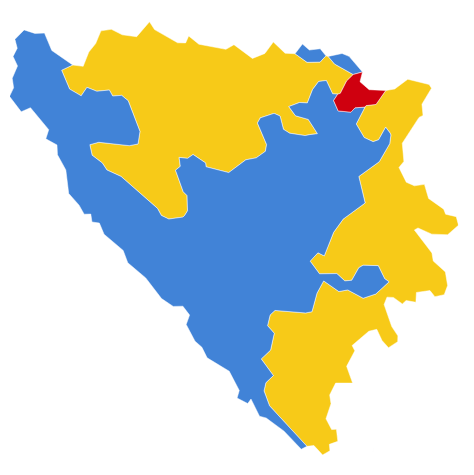Bosnia and Herzegovina: Where your new chapter begins.
Bosnia and Herzegovina: Where your new chapter begins.
Bosnia and Herzegovina, located in the heart of the Balkans, is a country shaped by its layered history and geographic diversity. It combines dramatic mountain landscapes, lush river valleys, and a rich cultural history deeply rooted in the traditions of its people.
… is the larger, more northern region of the country, characterized by a hilly to mountainous landscape. It is also home to Sarajevo, the vibrant capital of the country, which offers a fascinating mix of historical and modern influences.
… is smaller and located in the south, known for its milder climate and karst landscapes. Mostar, the cultural heart of Herzegovina, attracts visitors from around the world with its famous Old Bridge. This region is also significant for viticulture, making it an important economic factor.
Bosnia and Herzegovina consists of two main entities: the Federation of Bosnia and Herzegovina and the Republika Srpska. A smaller third region, the Brčko District, holds a special status and belongs administratively to both entities.

The Federation of Bosnia and Herzegovina is further subdivided into ten cantons. Each canton has its own government and is divided into additional local community units. These cantons are both ethnically and administratively diversified to ensure fair representation of the population groups
In contrast, the Republika Srpska is a more unified administrative unit that does not have cantons but is directly divided into municipalities. Here, administrative functions are more centralized, and the government of Republika Srpska is based in Banja Luka, the largest city of the entity.
The Brčko District enjoys a special status and is jointly administered as a condominium by both entities. This district was created to promote ethnic diversity and minimize conflicts. It has its own administration and is directly subordinate to the state government.
The history of Bosnia and Herzegovina is a tale of the confluence and conflicts of various empires and cultures. From the Illyrians and Romans, through the Ottoman Empire to the influences of the Habsburg monarchy, each empire has left its mark, which is still visible today in the architecture, traditions, and multicultural society.
The cultural landscape of Bosnia and Herzegovina reflects its history. The population consists of three constituent ethnicities—Bosniaks, Serbs, and Croats—each maintaining their own religion and cultural practices.
Each ethnic group celebrates its own festivals and maintains its own culinary traditions, inviting visitors to enjoy Ćevapi, Burek, or the hearty meat dishes of Croatian and Serbian cuisine.
The rich cultural heritage is reflected in traditional dances, music, and crafts that remain alive in festivals and daily practices.
The religious diversity with Islamic, Orthodox, and Catholic communities leads to a variety of religious practices and holidays that take place throughout the year. These religious events are often public and provide an excellent opportunity for locals and visitors to experience the spiritual and cultural diversity of the country.
Discover the stunning nature and diverse landscape of Bosnia-Herzegovina
Bosnia-Herzegovina is a country marked by an impressive diversity of natural landscapes—from lush forests and rushing rivers to rugged mountains and tranquil lakes. These geographical features offer not only spectacular views but also numerous opportunities for outdoor activities.
The Dinaric Alps traverse much of the country, offering spectacular mountainous landscapes ideal for hiking, mountain biking, and winter sports. The highest point of the range in Bosnia-Herzegovina is Mount Maglić on the border with Montenegro, which reaches 2,386 meters.
Bosnia-Herzegovina is rich in vibrant rivers such as the Neretva, Una, Vrbas, and Bosna, which are perfect for rafting and kayaking. Kravica waterfall, a stunning cascade over 25 meters high on the Trebižat River, is a popular excursion destination and a breathtaking natural spectacle.
Una National Park is renowned for its crystal-clear waters and the dramatic waterfalls along the Una River. The pristine nature offers perfect conditions for bird watching, fishing, and photography.
These two mountains were venues for the 1984 Winter Olympics and remain popular centers for winter sports today. With well-developed facilities for skiers and snowboarders, they also offer numerous hiking trails in the summer.
The Hutovo Blato nature reserve in the south of the country is a wetland of international significance and a paradise for bird watchers. It serves as an important resting place for many migratory bird species.
In addition to its natural beauty, Bosnia-Herzegovina also boasts rich urban and cultural landscapes. Sarajevo, the capital, offers a fascinating mix of Ottoman and Austro-Hungarian architecture, while Mostar with its famous Old Bridge serves as a symbol of connection and reconstruction.
These geographical highlights showcase just a snippet of the unique beauty and diversity of Bosnia-Herzegovina’s landscapes that attract visitors from around the world. Each of these areas contributes in its own way to the country’s cultural and ecological diversity, providing unforgettable experiences for nature and culture enthusiasts.
But there is so much more to discover! For instance, visit Neum, Bosnia-Herzegovina’s only access to the sea, where you can enjoy relaxing beach days. Or explore Međugorje, one of the most famous pilgrimage sites in Europe, attracting thousands of pilgrims annually. These and many other places offer unique insights into the rich history, culture, and natural beauty of Bosnia-Herzegovina.
We invite you to discover Bosnia-Herzegovina in all its glory and experience the many hidden treasures this country has to offer for yourself.